Gardening 101: How Bugs Can Help Your Plants Thrive
By: H. Davis
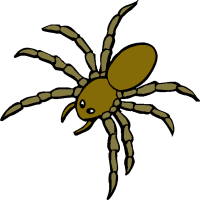 Did you know that over 50 percent of the world’s population today lives in urban areas with limited access to the natural world? In places like Europe and Latin America, this figure is even higher.
Did you know that over 50 percent of the world’s population today lives in urban areas with limited access to the natural world? In places like Europe and Latin America, this figure is even higher.
As we push ourselves more towards technology we become deprived of the physical world around us (nature). Fortunately, there’s one way we can stay connected to the environment right from the comfort of our home and it’s through gardening.
Because of gardening, individuals can interact with and strengthen their bond with nature, which benefits the body in a number of ways. For one, gardening can help individuals reduce stress and minimize their chances of developing:
- Various types of vein conditions
- Heart disease
- Depression
- Stroke
How? By keeping them active and allowing them to sit, stand, bend, lift, and walk around. These are all activities that encourage blood-flow throughout the body and prevent clots from forming inside the veins.
Aside from keeping us active on the daily basis, gardening also keeps us engaged with nature and everything that comes with it. That said, if you’ve started planting fruits or vegetables around your yard, expect to see insects. Bugs like sharpshooters, for example, will suck the life out of your plants by getting to the root of the plant and drinking all the water stationed there. If the plant doesn’t have water, there’s no way it can grow.
Thankfully not all bugs are bad for your plants. That’s why it’s important to know which insects can help your garden thrive. For the sake of this article, we are only going to focus on the good bugs — ones that allow you to get the results you worked so hard for, and ones that serve a meaningful purpose. Here a list of bugs you want in your garden:
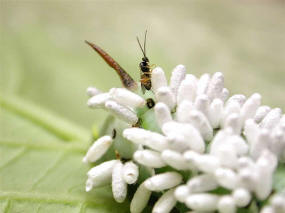
Adult Cotesia congregata wasps are very small (less than 1/8 inch) and pose no threat to humans, i.e., they do not sting.
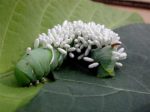
After larvae emerge through the body of a tobacco hornworm caterpillar, they spin silken cocoons. A total of 154 cocoons of Cotesia congregata was produced on this tobacco hornworm caterpillar.
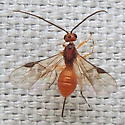
Pic courtesy of BugGuide.com
Braconid Wasps: Like flies, these wasps, in particular, attach their eggs to hornworms. The eggs then start to hatch and begin eating the hornworm alive, and by the time the wasps are fully developed, the worm is no longer alive. Considering the fact these insects can lay anywhere between 50 to 400 eggs at a time, their impact is immediately felt within the garden.
So if you see hornworms in your garden and they’re not trying to eat your plants or bury themselves in the dirt, leave them alone. The braconid wasp larvae have already taken effect. When those eggs mature, they’ll start to eat aphids, caterpillars, beetles, and flies as well. If you’re worried about being stung, just know that these insects don’t sting unless they have to. If you want to attract this bug into your garden, then you’ll want to have nectar plants with small flowers. This might include wild carrots and parsley.
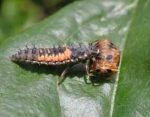
Ladybug larvae at different stages.
Ladybugs: Ladybugs are probably the most recognized insects out of all the beneficial bugs in the garden. The main reason ladybugs are so beneficial in the garden is due to the fact that they control the population of the bad bugs. In other words, ladybugs eat quite a few of the bad insects, which prevent your plants from being destroyed. Just how much can these bugs eat? Well, each insect can eat anywhere between 50-60 aphids per day and over five-thousand throughout the course of their life. They also like to snack on worms, leafhoppers, and mites, which can all go undetected if you aren’t closely monitoring your garden.
The best thing of all is that their offspring won’t harm your plants while being born, and they too will soon start to eat other insects as well. If you have enough fruits and vegetables in your garden that attracts enough bugs, you can have multiple generations of ladybugs in one area. If you’re worried potential predators eating the ladybugs, don’t be; ladybugs give off odors that other insects don’t like, so it’s unlikely they’ll be eaten by something else. Another reason ladybugs are so admired in the garden is due to their beauty. Although most ladybugs are red, they come in all different colors like orange and yellow, which gives life to a garden. The best way to get ladybugs into your garden is by planting dill and fennel. These plants also attract butterflies as well, so it’s a double win.
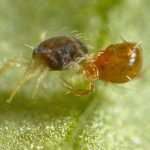 Predatory Mites: These tiny critters can actually help gardeners minimize the spider mite population in their garden. Unless, of course, you live in a humid environment that keeps them away. What makes predatory mites so interesting is that these insects actually thrive in humidity that come from sources like greenhouses. So if you’re dealing with bugs like spider mites, then you’ll want to predatory mites around to help get rid of the problem.
Predatory Mites: These tiny critters can actually help gardeners minimize the spider mite population in their garden. Unless, of course, you live in a humid environment that keeps them away. What makes predatory mites so interesting is that these insects actually thrive in humidity that come from sources like greenhouses. So if you’re dealing with bugs like spider mites, then you’ll want to predatory mites around to help get rid of the problem.
 Spined Soldier Bugs: Yes, it’s true, although these bugs aren’t pretty to look at, they’re still good for your garden. Why? Well, because these insects keep the population of other harmful bugs down. The most difficult part of keeping these bugs around, however, is making sure the soldier bugs you see in your garden aren’t the ones that can kill your plants. So, how can you tell the bugs apart from the bad ones? By looking at their color. The good bugs, for example, have colors on their legs. The bad ones don’t. Sounds pretty easy, right? Well, it is, but it’s also to get them confused if you aren’t careful. You just have to make sure that you keep a close eye out.
Spined Soldier Bugs: Yes, it’s true, although these bugs aren’t pretty to look at, they’re still good for your garden. Why? Well, because these insects keep the population of other harmful bugs down. The most difficult part of keeping these bugs around, however, is making sure the soldier bugs you see in your garden aren’t the ones that can kill your plants. So, how can you tell the bugs apart from the bad ones? By looking at their color. The good bugs, for example, have colors on their legs. The bad ones don’t. Sounds pretty easy, right? Well, it is, but it’s also to get them confused if you aren’t careful. You just have to make sure that you keep a close eye out.
If you’re having a difficult time getting rid of beetles, these insects are going to be your best friend when it comes to fixing the problem without relying on harsh chemicals. The best way to attract these bugs into your backyard forest is by placing flowers around the bed area of your garden. This gives them shelter to hide and adds natural beauty to your environment.
Having bugs in your garden might scare you at first, but when you realize how much they can help your garden thrive, you’ll come to appreciate them. By relying on the insects listed above, your garden can survive without poisonous chemicals being. In return, this will make the food you grow taste even better knowing it’s all natural. If you absolutely must use chemicals to reduce the bug population in your home garden, remember to protect your eyes by wearing sunglasses and hats. These won’t only help keep the sun out your eyes, it’ll also protect your eyes against muscle strain and potential sun damage. Covering your skin can reduce the chances of you developing a rash or getting unwanted bumps somewhere on your body.
Pics courtesy of Galveston County Master Gardener Association, Inc. (GCMGA) 2002-2017 GCMGA
–––––––––––––––––––––––––––––
Thanks for the read. Did I miss anything super important? What are some other ways bugs can help your garden thrive? Feel free to leave a comment below.
H. Davis enjoys being active and finds any excuse to go outside and explore the outdoors. If you can’t catch him online, you might be able to catch him working out at the gym or cheering on the Boise State Broncos. Follow him on Twitter at @Davis241. Thanks!-

